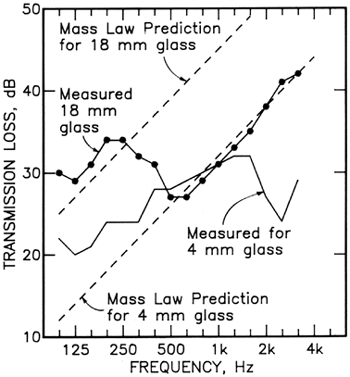Understanding Sound Reduction Through Windows
Don’t be disappointed!
Replacing your windows with energy efficient windows will not necessarily provide you with sound reduction. In fact many energy efficient replacements are noisier than the old windows.

Get all the facts before you buy.
Sound is heard through the weakest link, adversely the loudest sounds are heard; Example: If you are in a group of people who are talking, you must speak louder in order to be heard. The ability for something to reduce the amount of sound that passes through it is measured in STC or Sound Transmission Class – it is expressed on a scale of 0-100. 100 means complete soundproofing. To achieve an STC 100 would mean zero windows and concrete walls about 3 feet thick. A typical house with brick walls would have an STC of approximately 60-65 on the walls. The problem is the windows – a typical thermal window with 5/8″ airspace has an STC rating of approximately 27-29. Therefore, the majority of the noise you hear is coming through your windows.
A bquiet Soundproof Window is a second window that is placed on the inside of your existing window. It consists of 6mm laminated glass with a minimum 030 laminate and heavy gauge aluminum frames that adapt to any interior. Think of it as a sophisticated storm window. In rare situations it can be mounted on the outside also. The goal is to mount the soundproof window at least 3-4 inches away from the glass of the existing window. Sound reduction is achieved with density and space. The further away the soundproof window is placed, the greater the sound reduction. For example, a soundproof window that is located 4 1/2″ away from the existing window has a 3-5 point higher STC rating compared to one that is located 2 1/2″ away.

Sound Transmission Through Windows
Originally published February 1988.
J.D. Quirt
Abstract
The influence of typical window characteristics on sound transmission are discussed.
Introduction
In addition to their primary function as visual openings, windows also transmit sound. This is of concern not only for the exterior surfaces of a building, but also for interior applications ranging from office doors to control booths in recording studios. Sound transmitted through windows often limits the overall acoustical insulation.
Sound transmission through windows is governed by the same physical principles that affect walls,1 but practical noise control measures are influenced by the properties of glass and the characteristics of window assemblies. Increasing the glass thickness, for example, gives greater noise reduction at most frequencies, but the stiffness of glass limits the improvement. using multiple layers (double or triple glazing) increases noise reduction at most frequencies, but this is dependent on the separation of the layers.
As with other building assemblies, transmission of sound through cracks may drastically reduce the effective noise reduction. This is of particular concern for openable windows: even windows with good weatherstripping have reduced noise reduction because of air leakage. Most of the data presented in this Digest are for sealed windows. A procedure to estimate the change in noise reduction caused by air leakage is presented at the end.
The acoustical terms used in this Digest such as decibels (abbreviated dB), were discussed in detail in Canadian Building Digest 236.2 Sound transmission loss (TL) is a standardised measure of the noise reduction in decibels for specific frequency ranges. General trends are presented here in terms of the sound transmission class (STC), which is the single figure rating of sound transmission most commonly used in North America. The STC is calculated by fitting a standard contour to the TL data.
Although the STC rating of building elements is generally satisfactory for ranking their reduction of noise from sources such as the human voice, it does not properly rate insulation against sources with strong low frequency content. Because most outdoor noise sources such as aircraft and road traffic are in this category, STC ratings are not sufficient for assessing noise reduction by exterior surfaces, as noted in the Standard defining the STC.3 A procedure giving the necessary corrections to the STC for noise control design of exterior surfaces has, however, been presented in an earlier paper.4
Sealed Single Glazing
The TL for a large thin panel would theoretically increase by 6 dB for each doubling of the sound frequency or the mass if the effect of stiffness were ignored. Although single glazing does approach this “mass law” behaviour at some frequencies, the stiffness of glass and the limited size of typical windows cause significant deviations from this prediction.
Mass law predictions and actual TL curves for two examples of sealed single glazing are presented in Figure 1. The mass law predicts more change in TL with increasing frequency than is measured for real windows.

Figure 1. Sound transmission loss (TL) for sealed single glazing
At lower frequencies the measured TL is higher than the mass law prediction; this occurs because of edge constraints and the size of the window relative to the wavelength of sound waves. These effects are generally insignificant for large surfaces such as the walls separating rooms, but they increase the TL for small panels such as typical windows. How much the TL is increased depends both on the size and shape of the window and on how the glass is mounted in the frame. using soft resilient seals (such as neoprene gaskets) can increase the low frequency TL by several dB.
At higher frequencies, the measured TL drops far below the mass law prediction. This sharp decrease in the measured TL is commonly called the “coincidence dip”.1 It is caused by bending waves in the glass panel. The frequency at which this occurs is inversely proportional to the thickness of the glass. For 2 mm thick glass, the coincidence dip would be near 5 kHz. For 18 mm glass, the coincidence frequency is in the 500 Hz band, as shown in Figure 1. Near 500 Hz, the TL for 18 mm glass is actually lower than that for 4 mm glass. For frequencies above 200 Hz, the measured TL for 18 mm glass is far below the performance predicted by mass law. Because of this effect, the STC rating for single glazing increases very little with increasing glass thickness.
Above the coincidence frequency, laminated glass (consisting of two or more layers of glass bonded together by thin plastic interlayers) can provide much higher TL than solid glass. Laminated glass may closely approach mass law performance above the coincidence frequency. This improvement is apparently due to damping (dissipation of vibrational energy) by the plastic interlayers. It should be noted, however, that damping is normally temperature dependent.5 At typical Canadian winter temperatures, the increase in TL due to glass lamination may be drastically reduced.
Transparent plastic (including impact resistant polycarbonate) is sometimes used instead of glass. Typical plastics provide noise reduction similar to that for glass of the same mass. For example, the TL for 8 mm thick plastic resembles that shown in Figure 1 for 4 mm glass, which has approximately the same weight.
Sealed Double Glazing
The TL of double glazing is strongly dependent on the features of the cavity between the two layers of glass.
The STC rating of typical sealed double glazing increases as the air space increases (Figure 2). For each doubling of the air space, the STC increases by approximately 3. The STC also increases with increasing glass thickness.6-8

Figure 2. Sound transmission class (STC) versus interpane spacing for double glazing 6
If the separation between the two layers of glass is small, the STC rating is only slightly higher (or may actually be lower) than that for a single layer of the same glass. This occurs because the air in the space between the two layers of glass acts like a spring transferring vibrational energy from one layer to the other. This causes an abrupt decrease in the TL that is commonly called the mass-air-mass resonance. The frequency at which this resonance occurs is given by the expression:

where t1 and t2 are thickness of the two glass layers and d is their separation, all in mm. The resonance falls within the frequency range of 200 to 400 Hz for typical factory-sealed double glazing, as illustrated in Figure 3. Much of the sound energy from aircraft or road traffic falls within this frequency range. By increasing the airspace and using heavier glass, the resonance frequency can be lowered to improve the insulation against such noise sources.

Figure 3. The effect of a small airspace on TL of double glazing
Below the mass-air-mass resonance frequency, the double glazing has the same TL as single glass with the same total glass thickness. Far above the resonance frequency, the TL is higher than that for either layer by itself, and increases (like the STC) approximately 3 dB for each doubling of the airspace.
Sealed Triple Glazing
Despite the widespread belief that adding another layer of glass must be beneficial, triple glazing provides essentially the same noise reduction as double glazing, unless the interlayer separation is very large. Figure 4 compares TL data for a double-glazed window with that for a triple-glazed window of similar total thickness. Below the mass-air-mass resonance frequency (about 250 Hz in this case) the TL of triple glazing is about 3 dB higher, consistent with the mass law prediction for increasing the window’s mass by 50%. At higher frequencies, the TL curves are almost identical. The STC ratings for the two windows are the same.

Figure 4. TL of double and triple glazed windows
The small difference between the TL of double and triple glazing is not restricted to factory-sealed glazing mounted in a single sash where total air space is normally 15 mm or less. Unless both airspaces are much larger than this, the STC of triple windows is very similar to that of double windows. For a double window with a large airspace, replacing one of the layers of glass with factory-sealed double glazing gives only a small increase in the STC.
Designing for Noise Control
In cases where substantial noise reduction is required, double glazing is the most sensible choice. The airspace should be sufficiently large to provide the desired TL.
Using different thicknesses of glass for double or triple glazing gives greater noise reduction. The highest STC values shown in Figure 2 are for double 6 mm glass; windows with 3 mm glass substituted for one of the layers of 6 mm glass would have equal or higher STC ratings. Using different glass thicknesses is effective because resonances for each layer fall at different frequencies. A ratio of about 2 in thickness of the glass layers is most effective.
Transmission of sound energy through the window frame can limit the noise reduction, especially for windows with high TL. The STC data in Figure 2 are for glass mounted in wood sashes supported in a wood frame 40 mm thick; tests showed that transmission through the frame was insignificant. Some tests with lightweight metal frames have given lower STC results, apparently due to vibrations transmitted by the window frame. In general, the use of lightweight frames should be avoided. If very high TL is required, using separate frames supported by structurally independent walls eliminates the problem of transmission through the frame.
Although filling the interior cavity with sound absorbing material (such as glass fibre) can significantly increase the STC for double layer walls, this is impractical for windows because of the need for transparency. Some noise reduction can be achieved by adding absorptive material to cover the surface of the frame around the perimeter of the cavity. This increases the STC only slightly, although increases of up to 10 dB may be achieved at high frequencies.
Although non-parallel mounting of the glass is a well established practice for windows in recording studios, no acoustical benefits of this practice are discernible in careful laboratory measurements. The TL of windows with slanted glass is essentially identical to that for parallel glazing with the same average interpane space. Parallel glazing at the maximum spacing permitted by the supporting wall gives optimum noise reduction.
Openable Windows
Sound transmission through cracks around openable windows reduces their TL relative to that for sealed windows, In general, the reduction in TL tends to be greatest for the high frequency bands. For a window with good weatherstripping, the STC is usually from 3 to 5 lower that that for an equivalent sealed window. The higher the STC of a sealed window, the more it is decreased by a given sound leak. The approximate reduction in the STC is given by the expression:
10 log10 [1 + .012(L/S)10STC/10] where L is air leakage in L/s at a pressure of 75 Pa, S is the window area in m², and STC is the rating for the sealed window.9
References
-
Warnock, A.C.C. Factors affecting sound transmission loss. National Research Council Canada, Division of Building Research, Canadian Building Digest 239, 1985.
-
Warnock, A.C.C. Introduction to building acoustics. National Research Council Canada, Division of Building Research, Canadian Building Digest 236, 1985.
-
Standard classification for determination of sound transmission class, ASTM E4l3-73. American Society for Testing and Materials, 1916 Race Street, Philadelphia, PA 19103, U.S.A.
-
Quirt, J.D. Controlling sound transmission into buildings. National Research Council Canada, Division of Building Research, Building Practice Note 56, 1985.
-
Yoshimura, J. and Kanazawa, J. Influence of damping on the transmission loss of laminated glass. Proceedings, Internoise `84, Vol. 1, p. 589_592, December 1984.
-
Quirt, J.D. Measurements of the sound transmission loss of windows. National Research Council Canada, Division of Building Research, Building Research Note 172, 1981.
-
Quirt, J.D. Sound transmission through windows: I. Single and double glazing. Journal of the Acoustical Society of America, Vol. 72, p. 834-844, September 1982.
-
Quirt, J.D. Sound transmission through windows; II. Double and triple glazing. Journal of the Acoustical Society of America, Vol. 74, p. 534-542, August 1983.
-
Sabine, H.J., Lacher, M.B., Flynn, D.R., and Quindry, T.L. Acoustical and thermal performance of exterior residential walls, doors, and windows. NBS Building Science Series 77, U.S. Department of Commerce, November 1975.

